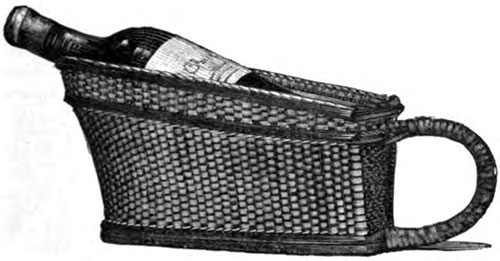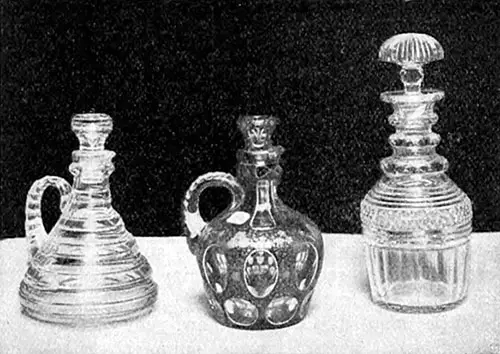Decanting, Warming, Cooling, and Serving Wines - 1902
.
Basket for Serving Wines
Wines and liquors are commonly in the keeping of the butler — in fact, the word " butler " is derived from the Latin buticula, a little bottle, through the French bouteillier, bottler. (Add a link to see Duties of the butler in Rights and Duties of Servants)
In the drinking habits of the old days, the care of the wine and liquors and the constant and gross serving of them might have kept a man busy in a ménage of not great size. In our own times, however, when wines are so commonly bought bottled, and the organization of households has become more complex, the duties of butler have broadened and refined.
Still the butler in these times has charge of the bottling and binning and of the temperature of the wine cellar or wine room, and he should know enough of that strange and living thing called wine to help his employer choose the right material, if his advice is asked, and to keep all wines and liquors in his charge under conditions most favorable to their development and perfection.

Old and New Glass Decanters
He should never leave wine in cases, but unpack and bin it as soon as it arrives. Rules for the decanting of wine have from time to time been given, but for Ports and clarets and such as show a deposit on the bottle, none are better than the following:
In decanting, the butler should first take all possible care in removing the bottles from their bins, and never fail to lay the bottle down on the side it has been laying in the bin. The deposit the wine has cast upon the side of the bottle not only destroys the brilliancy of the wine, but also its flavor and aroma.
Then he should be sure of the quality of each bottle, that is, he should guard against serving bottles tasting or smelling of corks rotten or decayed by fungous growths. It is hardly necessary to add that he should see that his decanter is brilliantly clean inside and out.
After he has taken the bottle of wine out of the bin he should carefully lay it on the table, keeping still the same position. If two laths have been nailed on his decanting table, he will have gained a steady base for work.
Let him hold the bottle tightly with one hand, and after slowly tipping it obliquely till the wine no longer touches the cork, he should apply his corkscrew and extract the cork without the slightest shake or movement to the bottle.
A candle set the other side of the bottle will permit him to see through the wine, and in drawing it into the decanter he should watch its condition. As soon as the cloud or deposit in the bottle nears the neck, he should stop; for not a particle of such deposit, cloud or crust, should flow into the decanter.
But this clouded wine should not be wasted. It will mix, especially if Port wine or Sherry. Put the bottoms of wines together in the kitchen-use bottle; for such mixtures are good for flavoring soups, puddings, and jellies.
Another good old-fashioned rule in decanting is this: When a bottle is three-fourths decanted, even if the deposit is still un disturbed, decant the remainder in a wine glass, and add from the glass to the decanter, as long as the cloud does not reach the glass.
Do not decant more wine than will be needed. The aroma is lost if the wine is too much exposed. Heavier wines should be decanted first; the lighter wines later, since their ethers are more volatile.
Old Sherry may be decanted the day before it is used, and the decanter left without its stopper. Hock, upon the other hand, should be decanted an hour before it is served.
Some judges of wine would decant claret as it is wanted, having kept it at a temperature of seventy degrees for ten or twelve hours before serving, while others would decant it two hours before it is drunk. Port should be decanted not more than two or three hours before it is served.
Champagne it is not necessary to decant when it is under ten years old. In opening Champagne bottles, cut the wire and strings at the bottle's rim. Then holding the cork down with the left thumb and with a pointed piece of wood, cleanse the rim. Extract the cork slowly so that no noise is caused, and have glasses at hand to hold the flow of a lively bottle.
In serving wines the taste of the guests should be considered, and after that the occasion, and the temperature and humidity of the outdoor air. Some temperaments and physiques with blood oxygenated by an outdoor life enjoy a heavier and rich wine; the sedentary student is apt to take a lighter and drier vintage. The milder wines naturally come first. If more than one quality of a wine is served, the younger should come first.
- Claret should be served warm — not warmer than eighty degrees and not cooler than sixty-five degrees. The medium point of seventy degrees brings out the qualities of the wine. The bouquet is lost if it is too warm.
- Bordeaux and Burgundy should have the same temperature as claret, except Chablis and other white Burgundy, which should be at forty-five degrees.
- Port should be served at a temperature of from fifty to fifty-six degrees — the point fifty-five is a much approved one.
- Madeira takes sixty-five degrees as the temperature best adapted to its constitution.
- Sauterne and other white claret fifty degrees, and
- Sherry is best at forty or forty-two degrees.
- Champagne should have a temperature of thirty-four. To cool this wine, lay it on ice, the sweet several hours before using, the dry for half or three-quarters of an hour. In laying the bottles on the ice, or in a pan of cracked ice, have care not to shake the bottle.
- With oysters may go Chablis, Sauterne, a light Moselle or Hock.
- After soup, an old Madeira or Tokay or Sherry.
- With fish, Sauterne, Hock, Chablis.
- With entrees, Claret, Bordeaux, Burgundy.
- With roasts, Champagne, Moselle, or fair claret.
- With game, Burgundy, claret.
- With Sweets, Madeira, Port, Sherry or Champagne.
People of a discriminating palate often pronounce for one good wine at a dinner. That wine, it should be added, is not Champagne — the drinking of which with all kinds of food some epicures pronounce a gastronomic sin. The same authority also advises us to avoid as poisons the serving and drinking of all brandies, whiskeys, and sodas, after wine.
Mrs. L Seely, Mrs. Seely's Cook Book: A Manual of French and American Cookery, New York: Grosset & Dunlap, 1902, p. 61-64.
